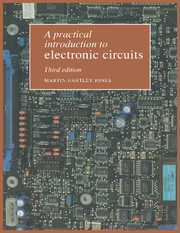Book contents
- Frontmatter
- Contents
- Preface to the third edition
- Preface to the second edition
- Preface to the first edition
- 1 Amplification and the transistor
- 2 The field-effect transistor
- 3 Thermionic valves and the cathode-ray tube
- 4 Negative feedback
- 5 Impedance matching
- 6 Semiconductor device characteristics
- 7 Amplification at high frequencies
- 8 Low-frequency signals, d.c. and the differential amplifier
- 9 Power supplies and power control
- 10 Pulse handling and time constants
- 11 Integrated circuit analogue building bricks
- 12 Positive feedback circuits and signal generators
- 13 Digital logic circuits
- 14 Microcomputer circuits and applications
- Appendix 1 Component identification
- Appendix 2 Transistor selection
- Appendix 3 Op amp data
- Appendix 4 Digital IC connections
- Appendix 5 Interfacing to the PC
- Bibliography
- Index
1 - Amplification and the transistor
Published online by Cambridge University Press: 05 June 2012
- Frontmatter
- Contents
- Preface to the third edition
- Preface to the second edition
- Preface to the first edition
- 1 Amplification and the transistor
- 2 The field-effect transistor
- 3 Thermionic valves and the cathode-ray tube
- 4 Negative feedback
- 5 Impedance matching
- 6 Semiconductor device characteristics
- 7 Amplification at high frequencies
- 8 Low-frequency signals, d.c. and the differential amplifier
- 9 Power supplies and power control
- 10 Pulse handling and time constants
- 11 Integrated circuit analogue building bricks
- 12 Positive feedback circuits and signal generators
- 13 Digital logic circuits
- 14 Microcomputer circuits and applications
- Appendix 1 Component identification
- Appendix 2 Transistor selection
- Appendix 3 Op amp data
- Appendix 4 Digital IC connections
- Appendix 5 Interfacing to the PC
- Bibliography
- Index
Summary
Amplification
The single most important function in electronics can be expressed in one word: amplification. This is the process whereby the power of a signal is increased in magnitude. A simple mechanical example of amplification is provided by the power steering system on cars and commercial vehicles, where a small force applied to the steering wheel by the driver is amplified hydraulically to produce the force required to move the front wheels of the vehicle. Here is the basic feature of an amplifier: a small input signal is used to control a more powerful output signal. The extra power is drawn from some external energy source, the latter being the vehicle engine in this instance.
The earliest example of electrical amplification is the electromagnetic relay, invented by Joseph Henry in 1835, and used by Samuel Morse to increase the power of weak telegraph signals. It was the relay which made possible the first long-distance telegraph line, from Baltimore to Washington, which was opened in 1844. As can be seen in fig. 1.1, the weak incoming signal is used to operate an electromagnet which attracts an armature and closes electrical contacts; these contacts then switch a powerful outgoing signal which is transmitted to the next leg of the line. The dots and dashes of the strong output signal are thus a faithful replica of the weak input. Relays are still used extensively in power switching systems, but are generally being superseded by electronic methods.
- Type
- Chapter
- Information
- A Practical Introduction to Electronic Circuits , pp. 1 - 33Publisher: Cambridge University PressPrint publication year: 1995



